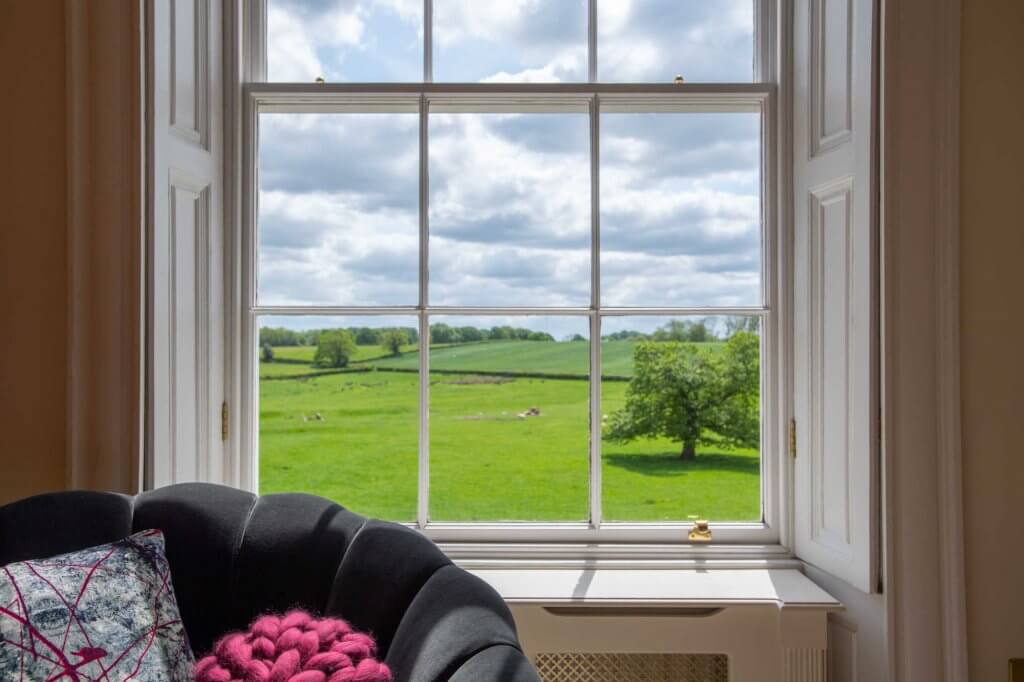How to Maximise Natural Light with Sash Windows
While sash windows add character to a property, ultimately their role is a practical one: Letting light in, allowing ventilation and providing an escape route, for example. But when it comes to the light they fill your home with, are yours doing the best job they can do?
Aside from needing light to live, light plays a large part in how we feel and how it makes a room feel. So let’s take a look at a few considerations – from easy wins to major overhauls – that could make a difference to the light in your home.
Where should you position your windows?
If you’re about to add new sash windows to your home, it’s vital to work with your architect to ensure that they are positioned in the correct place and they are of the right size. South facing windows will let the most light in – but your plot and situation of your home will dictate if this is possible. Trees or neighbouring buildings can also block natural light, so consider the external location of your home in tandem with the interior.
How big should sash windows be?
Size of individual windows will be dictated by the proportions of the room, by building regulations and by the era of your home (Georgian sash windows, for example, tend to be bigger). But size is also guided on the function of the room. A utility room or cloakroom may not require a big window, but a living space or bedroom will benefit from extra light. Too many small windows can limit the light entering your room, but conversely, too few large ones reduce your potential for ventilation.

What’s the best wood for new sash windows?
The finish of your window frames is also something to think about. Painting frames in bright and light colours can help light to bounce into a room. But if you are replacing existing sash windows or having new ones made, the wood used can make a big difference. At Ventrolla, we use Sapele and Accoya – both with beautiful natural grain patterns, so if you choose not to paint your windows, you can show the wood off with a clear coat of varnish. Rather than making a room darker, the natural warmth of wood can enhance the warmth of a room.
Both of Sapele and Accoya are sustainable, too. We take great care in sourcing and selecting our wood, which is treated with water-based paints and stains to prevent warping. This means our products are both non-toxic and recyclable, giving you peace of mind knowing that you are making an environmentally responsible choice.
Window treatments
Your choice of curtains and blinds can also influence how light a room feels. Heavy velvet or brocade curtains can block light – so try tie backs or holdbacks to keep them out of the way. But thick curtains can also give you the option to control the light in your room, and prevent the early morning sun waking you up. Fine voiles or lace curtains are great for maintain privacy without blocking the light – and shutters give you lots of control as you can adjust the slats or fold them all the way back.
Sparkling clean windows
Finally, it might sound obvious, but cleaning your windows can make a surprisingly big difference to the light they let in. If you’re on a busy road or have pets who press their noses up against the glass, windows can get dirty more quickly. Trimming climbers away from windows is also a good idea – not only to prolong the life of frames and to remove sticky marks from the glass but also to maximise the natural light in your home.

Whether your sash windows need renovating or you’re looking to have new windows made, a free no-obligation survey by our experts will give you the chance to explore all your options. Contact Ventrolla today to arrange your appointment and look forward to a lighter, brighter home.
FAQs about natural light sources through sash windows
1. What is meant by natural light sources through sash windows?
Natural light sources refer to the sunlight that enters a room through windows, providing illumination without the need for artificial lighting. In the context of sash windows, it specifically relates to the amount and quality of natural light that can pass through these types of windows.
2. Do sash windows allow a significant amount of natural light into a room?
Yes, sash windows can provide an excellent source of natural light. Their design, with large glass panes and narrow frame profiles, allows for ample sunlight to enter the room, brightening up the space and creating a pleasant atmosphere.
3. Are there any specific types of glass or glazing used in sash windows to enhance natural light?
Yes, there are various types of glass and glazing options available for sash windows that can enhance natural light transmission. Some examples include low-emissivity (low-e) glass, which reduces heat transfer while allowing ample sunlight to pass through, and slim double glazing, which improves insulation while still allowing natural light to enter.
4. Can the orientation of a sash window affect the amount of natural light it lets in?
Yes, the orientation of a sash window can impact the amount of natural light it allows into a room. Windows facing south generally receive more sunlight throughout the day, while those facing north may receive less direct sunlight. East-facing windows receive morning sunlight, while west-facing windows receive afternoon sunlight.
5. How does natural light through sash windows benefit a room?
Natural light has several benefits for a room. It can make the space feel more open, enhance the overall aesthetics, improve mood and well-being, and reduce the need for artificial lighting during daylight hours, thereby saving energy.
6. Can sash windows be used in rooms where privacy is important?
Yes, sash windows can be equipped with various treatments to address privacy concerns while still allowing natural light in. Options include frosted or obscured glass, window films, blinds, curtains, or shutters that can be closed when privacy is desired.
7. Can sash windows be energy-efficient while still allowing natural light?
Yes, sash windows can be designed to be energy-efficient without compromising on natural light. By using appropriate glazing options, such as low-e glass or double glazing with insulating properties, sash windows can minimize heat transfer and maximize energy efficiency while still allowing ample natural light into the room.
8. Are there any maintenance considerations for sash windows to ensure optimal natural light transmission?
Regular maintenance is important for sash windows to ensure they remain in good condition and allow optimal natural light transmission. This includes cleaning the glass regularly, ensuring the window frames are well-maintained and properly sealed, and addressing any issues with the window hardware or mechanisms to ensure smooth operation.
